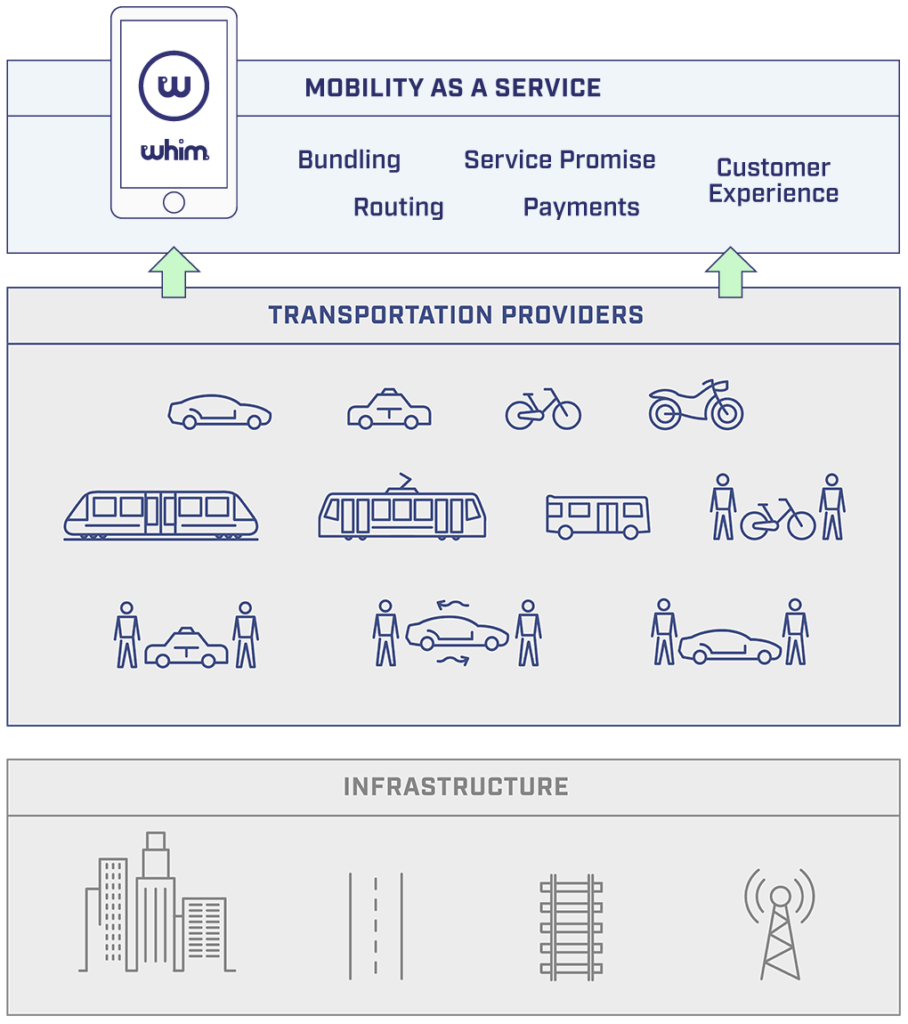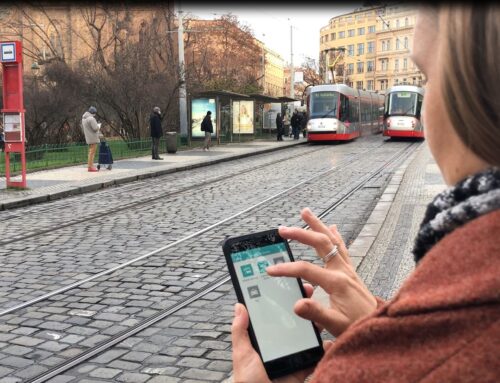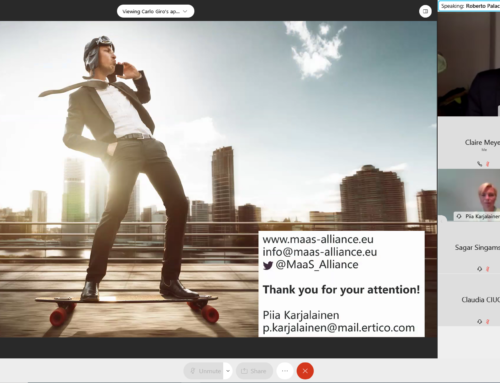Making a Difference with MaaS
An interview with Gorazd Marinic, IRU project manager for MyCorridor
Published on September 7th, 2018
Gorazd Marinic is the project manager for MyCorridor at IRU Projects in Brussels. On the 31st of August, Gorazd met with a colleague from communications to discuss what the ‘Mobility as a Service’ (MaaS) concept is, why MaaS solutions will benefit mobility service providers, who will be involved in the piloting phase of MyCorridor, what possible obstacles lay in a future deployment of MaaS, and where the MyCorridor project is going next.
For new followers who aren’t already familiar with the ‘Mobility as a Service’ concept, could you start off with an explanation of how MyCorridor relates to ‘MaaS’?
Gorazd Marinic: In the MyCorridor project, the consortium partners are developing and piloting the MaaS platform. MaaS means “mobility as a service,” which is basically where many different means of transport, or ‘modes’ – for example shared bicycles and shared cars, public and private buses, trains, et cetera – are made available in different ways than what we have now. So instead of buying one ticket and doing one trip, you pay for the services that you need. You could, for example, buy a monthly subscription package which includes services from different providers.

A conceptual framework for MaaS (MaaS Global)
Simply put, the concept is that instead of buying separate transport tickets for each service, you could buy one package that includes all the services for travel which you would need to get from A to B according to your current needs, without all the limitations of services which you already use. Travelling from one country to another, a user will not need to check travel options on multiple websites, or buy several different tickets. Using the MyCorridor solution instead, she would be able to use a single mobile app to check and search for the mobility options she needs, and also buy tickets without the need for who knows how many tickets and receipts in her pocket.
Therefore, the pricing model becomes much more flexible, thanks in part to the aggregation of services through MaaS but also because the user is encouraged to take advantage of services which they might not already be aware or make use of, such as shared bicycles or shared car services. MaaS platforms essentially make it easier to compare the cost, duration and availability of various services and modes of travel. This gives the user much more choice, makes it easier for smaller transport services with limited advertising to gain visibility in the market, and promotes the use of environmentally-friendly modes of travel.
How will the piloting phase of MyCorridor work?
We will run pilots in six different sites across Europe. Compared to other MaaS initiatives, MyCorridor is creating cross-border corridors between these sites which will require the user to traverse national borders and make use of multiple modes of transport. These include corridors stretching from Greece to Italy, then to Austria, to the Czech Republic, to Germany, and finally to the Netherlands. By piloting MaaS on a continental scale, MyCorridor has set out to demonstrate the capabilities of MaaS technology – accessed in this case via a mobile app solution – to provide a “One-Stop-Shop” solution for European travelers. It’s all about interoperability and aggregation of transport modes, traffic data and services. It’s exciting to see what the coming pilot studies next year will reveal.
Who will be participating in the pilots?
The idea is to involve real travellers, making real journeys, in order to learn what their actual mobility needs are. We will ask them to help us shape how the solution is developed. We will test various user interfaces, incentives and business models in order to understand how such solutions need to be developed and deployed in real life; so that they are interesting for transport companies and users. We want to cover different kinds of users – so this means daily commuters, occasional travellers, business users, elderly people, and so on.
Once again, this cross-border aspect is very important because today you have just too many single solutions that are limited to a certain city or region. When you move to a new city or visit a new city as a tourist, you need to install multiple new apps and create accounts for each kind of transport, registering all of your information – user name, address, bank card, passwords, etc – several times over and over. MyCorridor will instead provide a single entry to European mobility, assisting in a modal shift away from private car dependence.
Piloting MaaS on a continental scale, MyCorridor has set out to demonstrate the capabilities of MaaS technology and to provide a “One-Stop-Shop” solution for European travelers. It’s all about interoperability and aggregation of transport modes, traffic data and services. It’s exciting to see what the coming pilot studies next year will reveal.
– Gorazd Marinic
You came up with a metaphor to illustrate the current issue due to data format compatibility and how MaaS can provide a solution. When one travels outside of the EU – say, to Switzerland, to the US, or the UK – they’ll quickly notice that their charging cable is incompatible with the wall sockets. There is a need to have an adapter plug to charge your mobile devices. Is MaaS, in other words, an “adapter” to make ‘inter-compatible’ all the various national mobility services? Am I understanding that correctly?
I would rather say that – an enabler of MaaS would be the agreement on what kind of interface to use to provide the mobility service. This is analogous to agreement on a specific “shape” of your adapter plug to use when travelling. Let’s say all the taxi services in Europe agree to use the same data format interface – the same ‘API’, as it is called in the IT world. This agreement makes it easier to integrate services into a MaaS offering, and that multimodal offering or aggregated product could take the form of an all-inclusive return journey, a monthly subscription, or an employee transportation allowance for example.
Do you see any obstacles in the way of implementing MaaS as a business model across Europe?
There is always a question of who should be in the “driver’s seat” when it comes to MaaS implementation. One view is that public transport providers should take the lead because they are not profit driven. Another view is that public transport providers are less flexible than, say, start-ups when it comes to implementing new technology or new business models. They do not focus or specialize in providing new solutions in a way which can be quickly adopted by users. At the same time, MaaS solutions are basically an aggregation of different service providers on one platform. This is very similar to how the hospitality industry uses websites like booking.com. They provide different services under one umbrella interface, which is a purely IT solution in the end which anyone can replicate.
Agreements on the data protocols, data formats, legal liability, and so on provide an enabling environment for this kind of flexible aggregation and use of services. Because if, say, Ryanair wants to provide taxi services in a city in Ukraine, it would be much easier for them if the taxi service there already provides their interface through the same data format, which is standardised.
Would you make the case that MaaS-enabled platforms would do for the transport industry what websites like booking.com do now for the hospitality industry?
Yes, very similar. There is quite a good analogy to be made… I often mention this analogy when talking about MaaS, but it is not the only one. This aggregator role – putting all of these services and related data under one access point – is only one of the ways to provide mobility as a service. Let’s say that you’re a bus operator with a mobile app. The app will provide your bus service and maybe on top of that you could provide other services, such as “last mile” transport by taxi. So your user would take the bus to the bus station, and then take the taxi to the airport or hotel or wherever their final destination is. Your bus operation could be selling not just a ticket from station to station, but they would sell the entire journey, including each mode of transport, door-to-door, from beginning to end.
So what do we have in the pipeline in terms of upcoming MyCorridor events?
A cluster meeting of the three EU-funded MaaS project consortia – IMOVE, MaaS4EU, and MyCorridor – will take place in mid-October in Rhodes, and the second MyCorridor workshop will take place in Rome in mid-November. For the workshop we have invited service providers and mobility experts – legal and technical and business experts mostly – in order to discuss and learn how MaaS solutions should be developed. We will tackle the legal and practical requirements in focus groups with presentations by experts on MaaS. The idea is to get their input, test our assumptions, disseminate our work and talk about our achievements so far on the project. Then the initial piloting phase will commence.
This interview took place on the 31st of August in the offices of IRU’s EU delegation in Brussels. IRU is the world road transport organisation. IRU Projects is a recipient of EU-funding (Horizon 2020) and is one of 17 consortium partners collaborating on the MyCorridor project.







